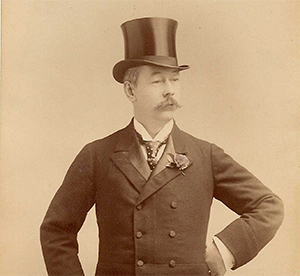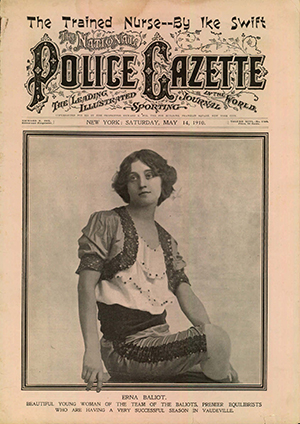Richard Kyle Fox and his National Police Gazette
Published in Features, Issue 1 (January/February 2020), Volume 28The Irishman who sold sex, sport and sensationalism in late nineteenth-century America.
By Liam Barry-Hayes
 Richard Kyle Fox was born on the Albertbridge Road, Belfast, on 12 August 1846. His father, James, was a carpenter and his mother, Mary (née Kyle), was the daughter of a Presbyterian minister. As a teenager Fox worked as an office boy for the Banner of Ulster before later working for twelve years in the commercial department of the Belfast News-Letter. He arrived in the United States in September 1874. Continuing his trade there, he landed a position at the Commercial Bulletin within days of his arrival at the immigration station at Castle Garden, New York. He subsequently became business manager at the then-foundering National Police Gazette and by late 1876 had taken ownership of the publication in lieu of back wages, transforming the weekly into a profitable business.
Richard Kyle Fox was born on the Albertbridge Road, Belfast, on 12 August 1846. His father, James, was a carpenter and his mother, Mary (née Kyle), was the daughter of a Presbyterian minister. As a teenager Fox worked as an office boy for the Banner of Ulster before later working for twelve years in the commercial department of the Belfast News-Letter. He arrived in the United States in September 1874. Continuing his trade there, he landed a position at the Commercial Bulletin within days of his arrival at the immigration station at Castle Garden, New York. He subsequently became business manager at the then-foundering National Police Gazette and by late 1876 had taken ownership of the publication in lieu of back wages, transforming the weekly into a profitable business.
Pioneer of ‘yellow journalism’
Years before Joseph Pulitzer’s New York World and William Hearst’s New York Journal managed to master and monopolise the techniques of what later became known as ‘yellow journalism’, Richard Kyle Fox had been the pioneer. Printed on pink paper, and often featuring frolicking females on its front cover, the National Police Gazette provided an assortment of crimes, scandalous tales, extraordinary endeavours and the latest sports news. Wherever men gathered, from bar rooms to hotel lobbies, the ‘barbershop bible’, as it became known, was a welcome diversion from the stern decorum of the Gilded Age.
It was the Gazette’s woodcut illustrations of indecently attired females, often fighting, or fumbling gratuitously in controversial bloomer fashion, which proved as pleasing to Fox’s many readers as it was displeasing to those who denounced his publication as prurient, none more so than the special agent for the United States Postal Service and founder of the New York Society for the Suppression of Vice, Anthony Comstock (1844–1915). Comstock had Fox prosecuted on many occasions but this only served to increase the Gazette’s circulation. Titillated by these images of playful soubrettes, those who were not imbued with Comstock’s Victorian ideals could also turn to the advertisements section of the Gazette to avail themselves of cures for ‘private troubles’, including ‘Dr Young’s Patent Electric Belt’ device, which ‘guaranteed to restore manhood’. Other items which could be discreetly delivered anywhere in the United States included ‘rubber goods’, illustrated French playing cards and imported pictures of ‘men and women together’.

Above: Scenes and incidents of President Garfield’s assassination from the National Police Gazette, 16 July 1881. (fultonhistory.com)
Boxing promotion
It is for the promotion of boxing, however, that Fox is best remembered. When he took over the Gazette in 1875, boxing was illegal in all parts of the United States, and those spectators and participants travelling to the clandestinely organised pugilistic contests risked prosecution just by being present. Following the Gazette’s coverage of a fight between Tipperary native Paddy Ryan and Joe Goss of England in 1880, circulation rose from 150,000 to 400,000 copies a week, prompting the Belfast proprietor to engage in the promotion of prizefights.
Fox’s supposed ongoing feud with the popular ‘Boston Strong Boy’, John L. Sullivan, proved a convenient sales strategy for the former’s weekly publication. This lively discord between Fox and the popular pugilist is thought to have originated in late 1881 at Harry Hill’s Saloon (then a popular entertainment venue), New York, when an inebriated Sullivan refused an invitation to join the Belfast man at his table. Over the next couple of months Fox’s determination to humble the insolent Bostonian allowed him to master the art of boxing promotion by becoming one of the first to sponsor ring matches with belts, cash and other prizes, and to use his publication to fight against laws banning prizefighting. Fox was determined to match Sullivan against Paddy Ryan. When the fight was eventually organised, Ryan, whom Fox had declared ‘Police Gazette champion’ in order to coax Sullivan into fighting, had his colours displayed in the barbershops and saloons whose proprietors were regular subscribers to the Gazette. Fox’s publication even went so far as to reassure those intending to travel to the fight that, despite the state of Louisiana’s attempt to hasten a legislative bill in order to prosecute those involved in prizefighting, the bout would be over by the time the law was enacted. The fight took place on 7 February 1882, not in Louisiana but in Mississippi. Sullivan easily dispatched his opponent in the ninth round, prompting Fox to immediately declare that he would put up $5,000 for a rematch (which produced a similar result).
The Gazette’s origins as a sensationalist journal began with Fox’s decision to send a journalist and accompanying sketch-artist to the scene of a murder at Madison, Connecticut, in September 1878. The victim, Mary Stannard, was an impressionable young woman in her early twenties, and the suspect, Herbert H. Hayden, was a married father and member of the clergy. What followed was an illustrated account of the events surrounding the murder, the subsequent arrest of the suspect and the trial’s proceedings. Gazette readers were afforded a unique journalistic experience. Fox referred to this method of reporting as ‘live journalism’ and he applied it to everything from sporting contests to presidential campaigns. When President James A. Garfield was shot by Charles Julius Guiteau at the Baltimore and Potomac railroad station on 2 July 1881, the Gazette kept readers informed on a weekly basis right up to when Garfield eventually succumbed to his injuries in September that same year. The colourful murder trial of Guiteau that followed was also given the Fox ‘live journalism’ treatment.

Above: The seven-storey ‘Fox Building’, Franklin Square, at the corner of Dover and Pearl Street, Lower Manhattan.
The ‘Fox Building’
In January 1883 Fox opened his new premises on the corner of Dover and Pearl Street, Lower Manhattan, overlooking the final stages of the construction of the Brooklyn Bridge. Designed by architect John Rogers of New York and constructed from Philadelphia-pressed brick with Belleville stone facings, the building was described by the Gazette as a ‘veritable palace of journalism, unequalled by any newspaper establishment in New York’. The ‘Fox Building’, as it became known, occupied seven floors and was replete with the finest furnishings of that era. The 7m-deep basement contained a large steam engine that powered the entire building. Above the basement, on the ground floor, were ten Hoe printing presses (a necessary inclusion, given that Fox’s company was now also publishing almost 50 sensationalist-type books). The building contained a museum of sports and sensationalism, including portraits of athletes, notorious criminals and the popular stage performers of the era. Facing onto Franklin Square, the private offices of Richard K. Fox were resplendent. Finished in polished hardwood and plate glass at a cost of $10,000, the offices contained furniture and artwork modelled on rare items from the Louvre Museum. When the Brooklyn Bridge finally opened on 24 May 1883, Fox’s decision to send out 10,000 invitations ensured that his new building was packed with journalists, dignitaries and some of the leading athletes of the day. It was from this new establishment that Fox continued to promote all manner of sports and unusual physical endeavours, notably Frank Samuelson and George Harbo’s remarkable 1896 crossing of the Atlantic in an 18ft rowboat called The Fox. It is estimated that Fox spent close to $1,000,000 in awarding belts, trophies and medals to athletes of every discipline.

Above: Cover of the National Police Gazette, ‘The Leading Illustrated Sporting Journal in the World’, 14 May 1910.
As the fin de siècle approached, Fox began to spend more and more time travelling around Europe. With wealth came a fondness for leisurely pursuits such as horse-racing and sailing. An honorary member of London’s infamous Pelican Club, Fox was well known amongst Britain’s aristocratic élite and became a close friend of Hugh Lowther, the extravagant 5th earl of Lonsdale. Indeed, in March 1891, following a drink-fuelled argument between Lonsdale and Lord Shrewsbury at Ingestre Hall, Staffordshire, about whether a trotter could beat a galloper over a four-leg, twenty-mile race, it was Fox who came to Lonsdale’s aid when on the day of the much-anticipated race the latter required a lightweight carriage. Lonsdale was victorious, albeit against the clock (as Shrewsbury never showed up owing to the inclement weather conditions), and the ‘Yellow Earl’ was greatly indebted to the Gazette proprietor for suggesting that he keep the carriage.
Decline
With his eldest son Charles at the helm in New York, Fox was spending six months a year in Europe and at his new offices in Fleet Street, London. The Gazette’s circulation declined rapidly during the late 1890s, however. In many ways Fox became a victim of his own ingenuity, as by the end of the nineteenth century many of the leading daily newspapers of the day had adopted the Gazette’s practice of featuring sex, sport and sensationalism. By the early twentieth century the National Police Gazette had lost its vigour. Historian Frank Luther Mott points out that it was the passage of the Volstead Act in July 1919, and the subsequent prohibition of alcohol, that delivered the fatal blow to the National Police Gazette’s solar plexus, for it cut off its entire bar-room circulation. Another factor was the increasing number of women who were frequenting tonsorial establishments in order to have their hair bobbed. The ‘Flapper style’, as it became known, encouraged a more sexually liberated generation, and the men who had hitherto enjoyed browsing the pages of the Victorian era’s most salacious weekly publication were less inclined to do so in the presence of these young, self-assured ladies of the Jazz Age.
Richard Kyle Fox died on 14 November 1922 after a long battle with pleurisy and was buried at Woodlawn Cemetery in the Bronx. His elaborate Egyptian-themed mausoleum was built (as instructed in his will) from the finest Westerly granite at a cost of $50,000. He was posthumously inducted into the International Boxing Hall of Fame (IBHF) in June 1997, along with fellow boxing promoter Don King. Fox is described by the IBHF as having done more to popularise boxing in the United States than anyone else in the nineteenth century. The National Police Gazette went bankrupt in 1932 and changed hands under various incarnations until it eventually ceased publication in 1977, at which time it was under the control of Canadian newspaper publisher Joseph Azaria. The legacy of Fox’s ingenuity is evident to this day and, though the journalistic medium has evolved, the public’s appetite for sex, sport and sensationalism, which Fox cleverly exploited in the late nineteenth century, remains unchanged.
Liam Barry-Hayes is a Ph.D student at the Department of History, Mary Immaculate College, Limerick.
FURTHER READING
G. Reel, The National Police Gazette and the making of the modern American man, 1879–1906 (New York, 2006).
E. Van Every, Sins of New York as ‘exposed’ by the Police Gazette (New York, 1930).
National Police Gazette Archives available at www.fultonhistory.com.
















